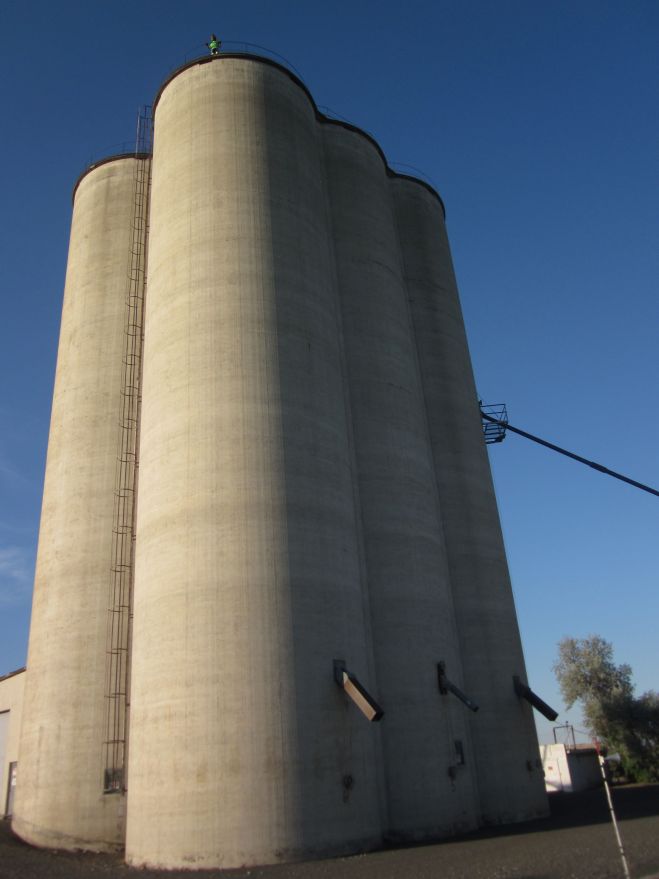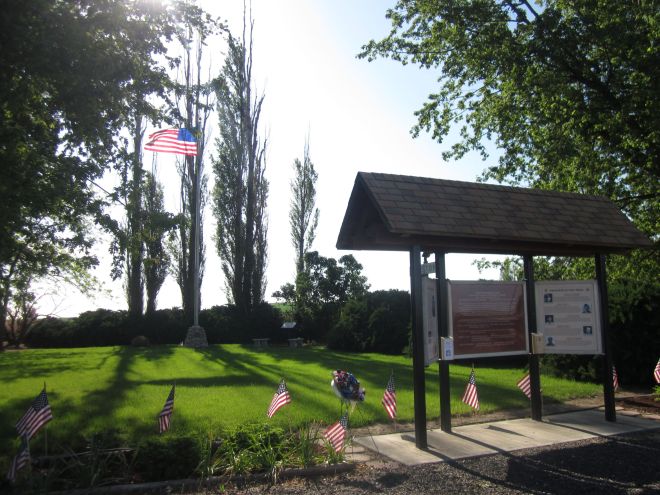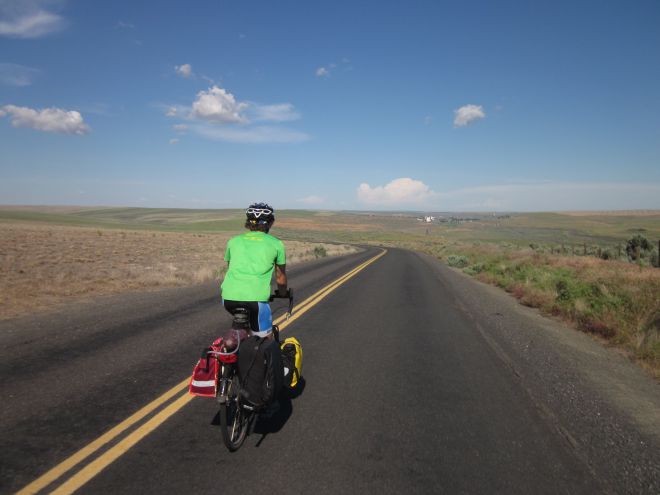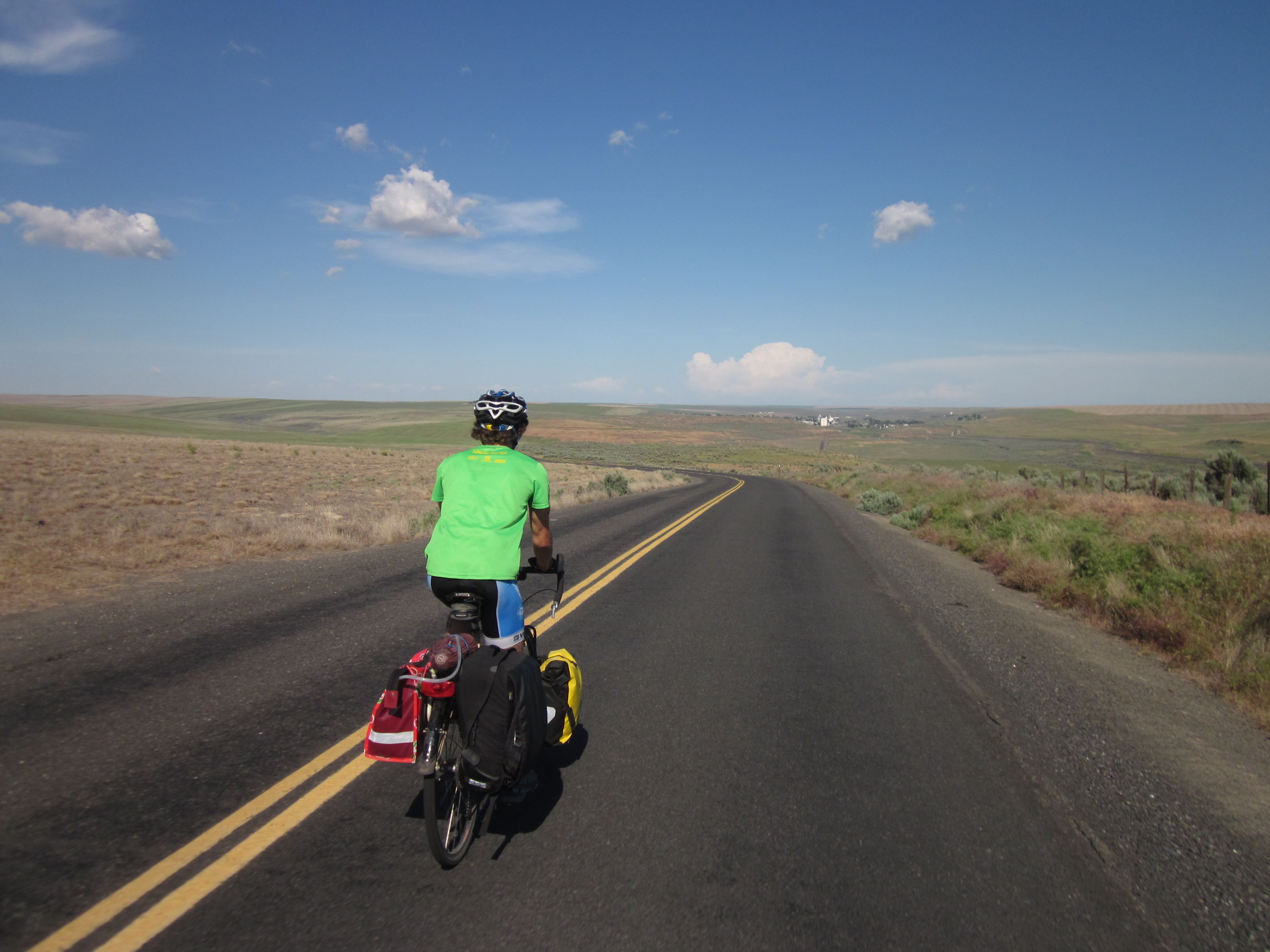Sam Bliss is traveling from Seattle to London by bicycle and boat. Read the intro to his travels here.
Small town Americans probably laugh at the urban fad called the sharing economy. In depressed rural areas, folks share simply because it makes sense and feels right.
At Jim’s Market in Lind, Wash. — one of two businesses still open in the once-thriving small town’s dozen or so storefronts — an elderly cashier brings a customer’s debit card over to the other till, where the grocer’s only card machine sits. She swipes the plastic, pauses, and hollers across the store, “What’s your PIN number, Harold?”
Harold recites his “secret” code for all to hear. I laugh, remarking to the cashier that people don’t typically yell out their PIN numbers in the city.
Things are different in Lind, she says. “I have most people’s PINs here memorized.”
Granted, it’s easier to share information and other things freely in a place where everyone knows everyone. The platforms of the sharing economy — whether it’s bullish!t sharing like airbnb or real sharing like couchsurfing — enable city dwellers to share with strangers, potentially building trust and forming new relationships.
But rural people don’t just reserve their generosity for neighbors, as my co-adventurer Neil Baunsgard and I found out over the first week of our cross-continent bicycle adventure. We’ve been overwhelmed by folks’ openness and generosity toward two strangers on loaded-down bicycles.

Bike parking at Jim’s Market in Lind, Wash.Neil Baunsgard
Jim’s Market ran out of Washington state road maps, probably some time ago. No one buys maps anymore, anyway, explains the store’s other on-duty employee, a strongly built, graying man who wants to help these travelers on their way regardless whether we’ll spend any money at the establishment.
While Harold runs the cash register, the kind clerk pores over the thick road atlas he’s retrieved from his truck, aiming to show us a bike-friendly route eastward, hopefully with a spot to camp out. We decide to head east another 15 miles to Ralston. After talking about our Homeric trip and their dying town for a few minutes, we thank our new friends and begin pedaling down the next in a series of impeccably smooth country roads.
There’s remarkably little traffic this late Saturday afternoon of Memorial Day weekend. At one point we climb up a grain silo and spend about 20 minutes enjoying the view of rolling wheat fields. Not a single vehicle passes during the shenanigans.

Sam atop a grain silo somewhere on Lind-Ralston Road.Neil Baunsgard
We stop in Ralston, which looks less like a town and more like six pickup trucks and a few dilapidated buildings around a deserted rail line. Our legs feel pretty good, but we need water, and the sun will set in about an hour and we don’t have a clue where we’ll sleep.
Neil and I approach a white car that’s about to pull out of the Ralston Grange Hall’s rocky lot. The woman behind the wheel tells us she lives nine miles down the road, but she points to the white house across the two-lane state route and attests she knows the folks who live there. We should ask them for water, she says. “If you see a spigot anywhere, it’s probably fine.” People share here.
We wheel our bikes to the other side of the road and down a short gravel driveway. The droopy-jowled dog laying in the yard doesn’t bark to announce our presence. “Hello!” says Neil in his typical sing-song, friendly way as he knocks on the back door. There’s no answer.
We fill our bottles at the spigot by the detached garage. We say hello to four adorable pigs running around their pen opposite the two-story home. We cross the road again, wading through tall grass to check out the abandoned house next door to the Grange hall — a potential shelter for the night. It’s all locked up, boarded up, and generally uninviting. We head back to our bikes to cycle on into the evening. It shouldn’t be too hard to find somewhere to lay down our sleeping bags in this remote country.
As we remount, there’s some shuffling behind us in the driveway. It turns out there were people home at the white house after all. Andy Robbins, a dark-haired man of Blackfoot descent, greets us with his 4-year-old daughter, Olivia, peeking out from behind her dad’s thick legs. Neil thanks Andy for unwittingly sparing us some water.
Andy is apologetic that they didn’t hear us knock rather than annoyed that we’d trespassed. “If you’re heading through town again, just know we’re normally in the basement,” he says. “Just crack the door and holler.”
It’s 7:45 and the sun’s hovering just over the Western horizon when Andy asks us where we’re planning to stay. He doesn’t wait for Neil to finish our incoherent “don’t know.” Bike travelers often stay right there in the park, Andy says, pointing to a patch of grass greener than anything in the surrounding dry farmland. He instructs us to switch off the sprinkler system that would otherwise soak us at midnight and asks that we turn it back on in the morning on our way out.
We quickly decide that yes, we’ll spend the night in this ghost town’s inexplicably well-maintained park, complete with a memorial to Ralston-born medal of honor recipient Reinhardt J. Keppler, a World War II hero who had a destroyer ship named after him in 1946. (I later learn that the community park was created and now maintained by the Ralston Grange, a group that somehow has nearly 100 members.)

Keppler Memorial Park in Ralston, Wash.Neil Baunsgard
“You want a beer?” asks Andy. Neil and I smile thirstily. I tell him we want to set up camp while it’s still light and then we’ll be right over.
Before we can even get all the bags off our bikes, Andy, Olivia, and the dog Gracie meet us at the park’s picnic table with five cans of Rainier. He tells us that it’s the official beverage of Ritzville, the I-90 exit town 10 miles north. I guess Ralston’s not important enough to have an official drink. Vitamin R-deficient after a hot day in the saddle, we’re thankful for the crisp refreshment.
Andy tells us what he knows about the history of Ralston, a booming rail town a century ago but now not even a stop on the route north to the interstate. Where the Milwaukee Railroad once ran, there’s now a hunting trail that we discovered is not even in condition to cycle on consistently.
I describe the grain elevator we passed a few hours ago that sits useless next to the old Milwaukee line, the current BNSF tracks in plain, painful sight. Andy looks down at his beer can and says matter-of-factly, “There’s a lot of painful stuff out here.”
When first transcontinental trains rolled through on the Milwaukee Railroad in 1909, the settlement had its own flour mill, two lumber yards, a grocery store, two blacksmiths, a two-story brick hotel, a school, and at least a dozen other busy buildings, according to a plaque in the park. But Ralston’s decline began well before the rail line moved. “The advent of the automobile and better roads provided easier access to larger commercial hubs, like Ritzville, and caused the sudden exodus from Ralston,” reads the stone sign commemorating the 2009 centennial.
The spectacular auto infrastructure that allows us to ride bikes through farmland on paved roads, rarely seeing a car, was the real demise of railroad towns like Ralston. When it seemed like oil would never be scarce (or destabilize the global climate), the United States built the world’s best highway system. Even though private vehicles are arguably the least efficient way to move people and goods, the legacy of decisions in the mid-20th century has made our country path dependent: There’s no way out of the climate crisis without tens of millions of electric cars, trucks, and buses drawing their charge from a greener grid. Or really good cargo bikes, a slowed-down economy, and strapping thighs.

Riding down Lind-Warden Road, one small segment of America’s impeccable, overbuilt auto infrastructure.Neil Baunsgard
These towns have certainly slowed down, but not by choice. Today’s growth-oriented economics necessitates constant acceleration to achieve any semblance of prosperity. Degrowth is not a viable option for a small community that’s been integrated into the competitive global marketplace.
When I relate Ralston’s downfall to that of nearby Lind, our afternoon stop, Andy says Lind was never a boom town, just a flourishing farm town. “Lind got bigger and bigger when 100 acres could support a family,” he says. “Now it takes 3,000 acres.”
Neil had asked the elderly cashier in Lind what caused the changes there. She first mentioned the Walmart in Ritzville, but then she started talking about the policies that have wreaked havoc on mid-size farms. When her family moved there in the 1960s, they were ranchhands. Most property owners had cattle, which meant people were needed to help out on their farms.
Then the U.S. government began to encourage wheat farming, fence-line to fence-line, with petroleum-powered machinery and chemicals rather than ecological know-how and human energy to restore nutrients and control pests. Even worse, the farm bill started to include payments for farmers not to grow wheat, in order to manipulate commodity prices on the international market. That really destroyed Lind, said the cashier forlornly. There aren’t jobs for farmhands these days.
Something about small, slow communities or economic contraction sure makes people share nicely, though. When Neil and I were setting off up to White Pass, just south of Mount Rainer, on our journey’s third morning, we stopped by the Packwood Lodge for some indoor plumbing and were offered banana-nut mini muffins from the continental breakfast — much-needed fuel for the breathtaking (pun intended) climb ahead. The evening before, Packwood’s little log-cabin library was happy to share its internets and outlets while we figured out our route. The librarians informed me multiple times that the wifi stays on from 6 a.m. to midnight, even when the building is closed.
As Andy Robbins and his daughter and dog get up to trudge 30-odd steps home for the evening, he tells us that he’ll leave some bug spray on the porch for us if he can find it, just in case the mosquitoes come out. He leaves us with the other two Rainiers, and says the old-time Pepsi machine in his garage is really just a beer fridge, encouraging us to help ourselves if we need some more.
Neil stands about 20 yards away, recounting the day’s events to his girlfriend Jane via (dumb) phone. I tell him to come closer because listening to his conversation helps me write it all down. This is how we collaborate; Neil’s a storyteller and I’m a writer.
It’s dark now. Stars speckle the blackness over our heads, while a magnificent lightning show brews in the Eastern sky. Crickets chirping and the U.S. flag waving in the wind are the only sounds we hear beyond the infrequent car passing.
“Alright. I’m going to get started on din din,” says Neil. “And talk to my mom at the same time.” The stories only get better with the second telling.

One lightning strike of many over Eastern Washington, as seen from Ralston.Neil Baunsgard
We’re cooking up the undamaged pieces of potatoes we found on the side of Lind-Warden Road — one of those superbly nice backroads — surely dropped by trucks full of spuds. We spent the first half of the day driving through ‘taterland after leaving from my grandma’s in Othello, a place that smells like french fries when the wind blows from the northwest, where a processing plant sits on the edge of town.
Neil identified these russets as McDonald’s potatoes by their square shape — perfect for cutting uniform fries. We’ll eat them directly from the shared pot that now sits upon the alcohol stove filled with antifreeze.
“I’m loving it,” I hear Neil tell his mom about traveling by bicycle. “I can’t believe I haven’t done it before.”
After six days, 350 miles, one tall mountain range, and countless ecosystems — concrete jungle; Cascade rainforest; channeled scablands; irrigated desert; sagebrush-dotted rangelands; orchard-covered plateaus; dry Ponderosa pine forests; hop vines as far as the eye can see through the Yakima Valley — I feel that way, too.




